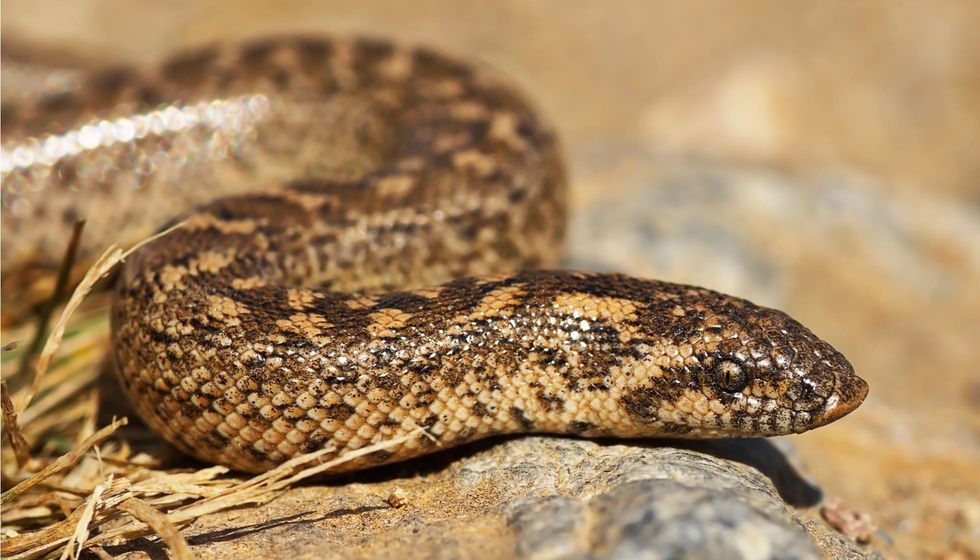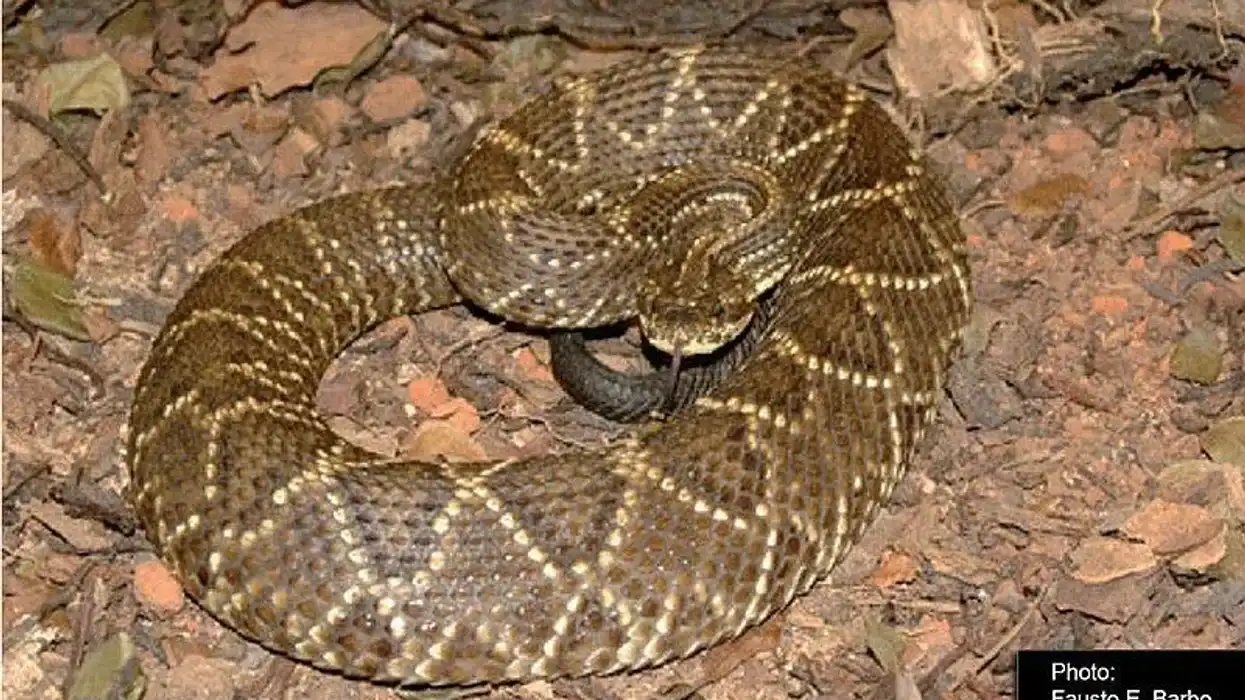Among the scaly species from the family of reptiles are the sand boa snakes with scales over the body.
According to the search work of Dr. Roy Mcdiarmid, a sand boa can be classified into several species including Asian sand boa (Eyrx elegans), Egyptian sand boa (Eryx colubrinus colubrinus, Eryx colubrinus loveridgei, and Eryx colubrinus rufescens), javelin sand boa (Eryx jaculus), Arabian sand boa (Eryx jayakari), Indian sand boa (Eyrx johnii), tartar sand boa (Eryx tataricus speciosus, Eryx tataricus tataricus, and Eryx tataricus vittatus), and many more.
Surprisingly, snakes are often considered to be poisonous or venomous, but the species of sand boa snakes are very useful and also help in the preparation of medicines, cosmetics, and sometimes are also used in black magic.
The species of Anguis jaculus or Eryx jaculus (javelin sand boa) was first documented by Linnaeus in 1758 in his book 'Systema naturæ per regna tria naturæ, Secundum classes, ordines, genera, species, cum characteribus, differentiis, synonymis, locis' with several other species of the world. The sand boa is a heavy-bodied snake.
The distribution map of the Eryx jaculus specifically highlights north African countries like northern parts of Morocco and south of Egypt, European countries like Sicily in Italy and Romania, and also places like southern Iraq, and many more.
If the uniqueness of the javelin sand boa makes you interested to read more about similar species, you can read about the scarlet snake and anaconda snake.
Javelin Sand Boa Interesting Facts
What type of animal is a javelin sand boa?
The javelin sand boa, Eryx jaculus, is one of the rarest European species of snakes. It is among the several subspecies of the sand boa.
The species are known by their common names as javelin sand boa snakes from the kingdom Animalia, and genus Eryx was considered extinct until a specimen was rediscovered in 2014 in one of the European countries of Romania.
What class of animal does a javelin sand boa belong to?
The javelin sand boa, Eryx jaculus, belongs to the kingdom Animalia, family Boidae, and genus Eryx. It is also documented in Volume 1 of the 'Journal of Natural History' published by Taylor and Francis.
How many javelin sand boas are there in the world?
While the javelin sand boa history highlights that the snake was speculated to be Extinct in 1937 in some of the European countries until was rediscovered in 2014, the population range varies from one geographic location to other. On the other hand, there are no estimated observations recorded about the population of the snake.
Where does a javelin sand boa live?
According to the scientific search, the Eryx jaculus (javelin sand boa) lives near several European, Asian, and African countries. The range map of the snake highlights eastern European countries such as Romania, Italy, Britain, and many others, Middle East Asia, commonly, Iraq, and near various areas of North Africa such as Egypt.
What is a javelin sand boa's habitat?
The javelin sand boa habitat varies and does not have a confined region. On the contrary, the species of the snake prefers sandy regions such as deserts.
Who do javelin sand boas live with?
According to the scientific search reports, the male species of the javelin sand boa cannot survive together as they are speculated to prey on each other, while a pair of females may live together. Furthermore, observations records highlighted that a male and female species of pair also survive together to undergo courtship.
How long does a javelin sand boa live?
The scientific observations recorded during various search exhibitions highlighted that the species of sand boa snakes can live up to 10 years in the wild and more than 20 years in captivity, while the lifespan may vary from one species to other. On the contrary, the estimated lifespan of the Eryx jaculus lacks appropriate observations.
The rosy boa is reported to live for more than 30 years in captivity.
How do they reproduce?
Since the javelin sand boa is a poorly studied species, it has limited search reports documented. Thus, the reproduction mechanism of the Eryx jaculus is not recorded so far. On the other hand, species of sand boa snakes are reported to give birth to 6-20 snakelets.
What is their conservation status?
The scientific species, Eryx jaculus, is listed as Least Concern under the IUCN Red List of Threatened Species. While the snake was speculated to be Extinct in several European countries on the map, it was rediscovered in 2014 and since then is considered to face no major threats.
Javelin Sand Boa Fun Facts
What do javelin sand boas look like?
The Eryx jaculus has small scales while the color varies. The heavy-bodied snake can be gray, tan-brown, red with an irregular pattern over its body. It has a blunt tail mostly short in length. Also, a yellowish or white streak runs from either eye to the corner of its mouth.
How cute are they?
The boa is heavy-bodied with variations in the color of its dorsal. The snake is often considered adorable considering the admiring pattern over its body. Moreover, the boa is neither poisonous nor venomous, hence, poses no danger. Also, it is one of the smallest species of snakes.
How do they communicate?
While there is no concrete search evidence specifying the communication mechanism of the species, it is speculated to communicate using chemicals called pheromones. Also, the species can communicate using various gestures and motions.
How big is a javelin sand boa?
While the sand boa is the smallest species of the snakes, the length of the Eryx jaculus is as long as 31.5 in (80 cm). It is 10 times smaller than a reticulated python as its length varies between 5-21.3 ft (1.5-6.5 m).
How fast can a javelin sand boa move?
The species of sand boa have an average moving speed as neither it is very slow nor very fast. They are recorded to move at the speed of 1 mph (1.6 kph). On the contrary, a black mamba is one of the fastest moving reptiles with a speed varying up to 12 mph (19 kph).
How much does a javelin sand boa weigh?
The weight of the javelin sand boa is not quantified, however, one of the heaviest snakes is reported to be a green anaconda that weighs up to 550 lb (250 kg).
What are the male and female names of the species?
The species reportedly have no sex-specific names.
What would you call a baby javelin sand boa?
A baby or juvenile javelin sand boa can be called a snakelet, hatchling, or neonate.
What do they eat?
The javelin sand boa diet comprises small birds, rodents, and insects such as lizards or mice. The snakes are carnivorous in nature and are said not to chase their food.
Are they poisonous?
No, the boas are neither poisonous nor venomous. The records and references do not reflect upon the possession of either javelin sand boa venom or poison. Rather, the sand boa snakes are useful in the preparations of various medicines, and cosmetics for human consumption – especially the desert sand boa.
Would they make a good pet?
The javelin sand boa has a peaceful and friendly temperament. The snakes do not mind being held or kept in captivity either.
It is advised to research them well to ensure the proper javelin sand boa care. The reptile species has a high demand and thus is reported to be one of the expensive species and the javelin sand boa for sale is bought between $500-1500.
Did you know...
While the sand boa species are considered oviparous, there are no specific records about the reproduction process in the javelin sand boa.
The species can survive up to a year without consuming anything. Also, they do not chase their food either.
They are terrestrial and prefer to spend time underground in sandy burrows.
Why are they called javelin sand boas?
While the scientific genus name has a Latin origin named after the mountain in the northwest corner of Sicily, the javelin sand bao was named so as the javelin sand boa (war weapon) was used as a javelin by the ancient Greeks during various battles.
Are javelin sand boas Endangered?
No, while the javelin sand boa was Extinct in some of the European countries, but it is now at no risk of being Endangered. Also, it is listed as Least Concern under the IUCN Red List of Threatened Species.
Here at Kidadl, we have carefully created lots of interesting family-friendly animal facts for everyone to discover! For more relatable content, check out these rubber boa facts and taipan facts for kids.
You can even occupy yourself at home by coloring in one of our free printable snake coloring pages.










